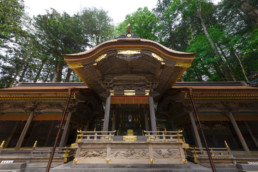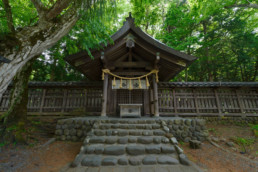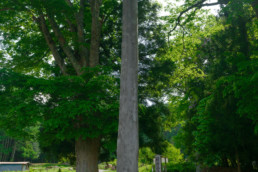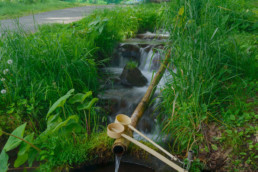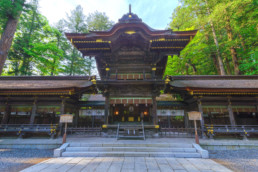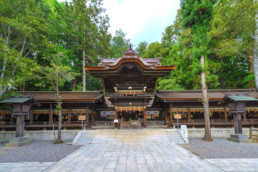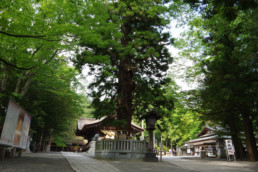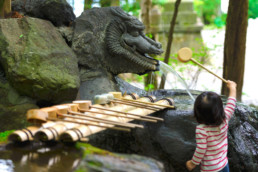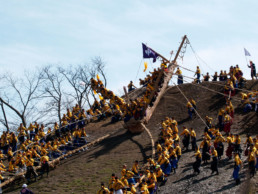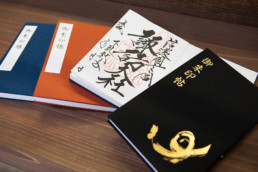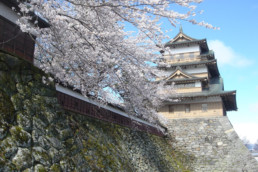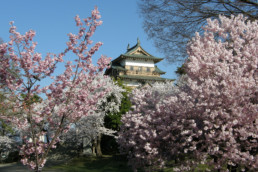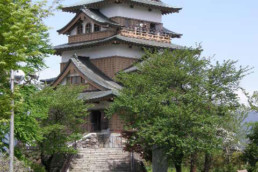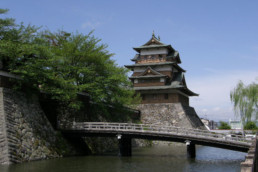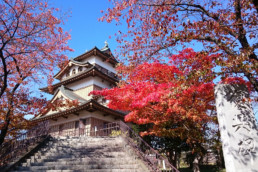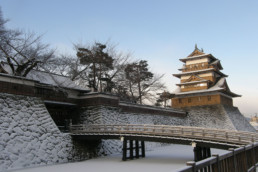Heritages in Suwa
SUWA TAISHA
Suwa Taisha is the head shrine of Suwa Shrine that is widespread in Japan. Taisha means Grand Shrine.Suwa Taisha is the four shrine complex that is grouped to 2 sites, Kamisha and Shimosha. Kamisha consists of Honmiya (main shrine) and Maemiya (former shrine). Shimosha consists of Akimiya (Autumn Shrine) and Harumiya (Spring Shrine).Honmiya had been worshiped as God of wind, water, agriculture and hunting. Since the Middle Age, many generals in the whole country had been believed in Suwa Taisha as God of war. Because of that, more than 10,000 branch shrines were established all over the Japan.It is unique that Suwa Taisha has no Honden (the building that normally enshrines a shrine's God) so that Suwa Taisha is designated to National important cultural property.
Shrine Complex
Honmiya (Kamisha)
Honmiya is unique "Suwa Style of Building" and is remaining the largest number of historical buildings in the 4 shrines.The current building has been rebuilt in the Edo era. It has remaining valuable buildings, such as the four-legged Gate by donation of Ieyasu Tokugawa, which are designated as an important cultural property of the country.
Harumiya (Shimosha)
Harumiya consists of 2 important cultural properties.Tsutsugayu-shinji, a shinto ritual which forecasts how rich or how poor the harvest of the coming year is held on January 15th every year at Tsutsugayu hall.It is assumed that the large Torii (a front guard frame) that made of granite is build in 1659. It is said that the builder is the same as one who made Manji Statue.
Akimiya (Shimosha)
You can find Komainu (Shinto guardian dog) of Akimiya, the biggest one made of bronze.The sculpture of the hall of worship, which was made in the middle of Edo era, is stunning. There are many attraction such as beautifully-decorated Kaguraden, 800 years old Japanese cedar as well.The hall of worship and kaguraden are both important cultural property of country.
Festival of Suwa Taisha
Onbashira
Onbashira is a grand festival that is held every 6 years by Suwa people. It is national famous festival for its courageousness and large scale.A large pillars, ones of those are 1 meter diameter 17 meter long and 12 ton kg each, are cut down out of Yatsugatake Mountains and brought to town by hand. At last they are raised at four quarters of each shrines.Yamadashi (First half of festival from mountain to town) is held for 3 days in April. And Satobiki (Second half from town to shrine and raising pillars) is held for 3 days in May.Not only grand festival, but also small festivals (called "Komiya") are held on each branch shrines during year.
goshu-in
Collecting Goshu-in Stamps
Goshu-in is a stamp that you can get by visiting shrines and temples as a proof of visit and for a memory of worship. To fill up the Gushu-in Boook is popular these days.Visitors of Suwa Taisha also get Goshu-in stamp. There are many people who buy Goshu-in Book and go touring around 4 shrines.There's unique ritual of Suwa Taisha, called Asamikesai. It is held every 6 o'clock in the morning to dedicate breakfast for God.Would you like to get up early and take look gracious atomosphere of Suwa Taisha?
Heritages in Suwa
TAKASHIMA CASTLE
Takashima Castle was built about 420 years ago by vassal of Hideyoshi Toyotomi.In those days the castle was built, it was impregnable because of its moat using water of Suwako. The castle had been honorably called "Floating Castle of Suwa".The current castle tower has been revived in 1970. First and second floors are the reference room of the local and Takashima Castle, the third floor has been used as an observation room.The castle has become famous park even for cherry blossoms and wisteria.
information
Takashima Castle
Hours April to September 9:00~17:30, October to March 9:00~16:30Close on December 26th to December 31stTEL. +81-266-53-1173Website (Japanese)


